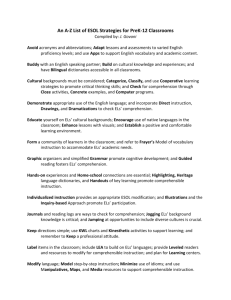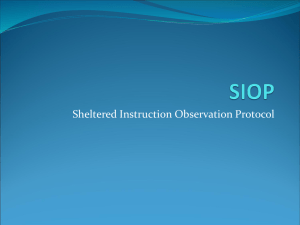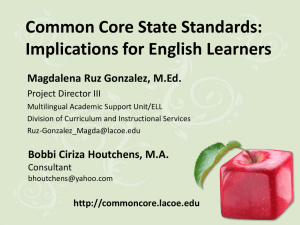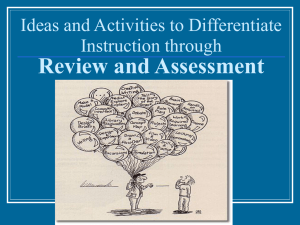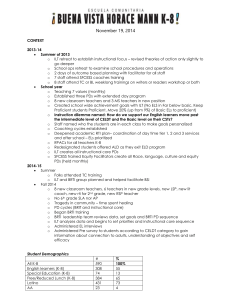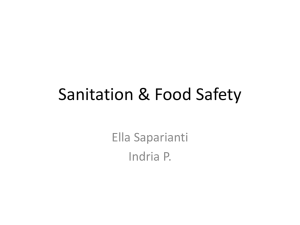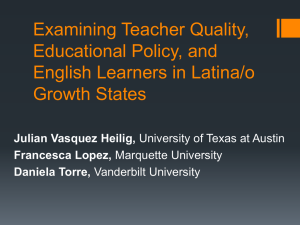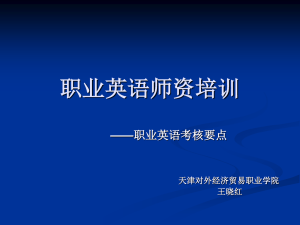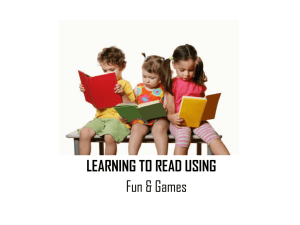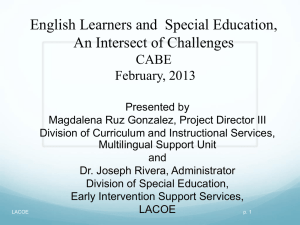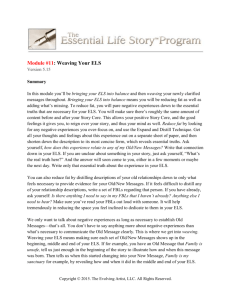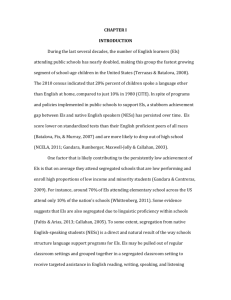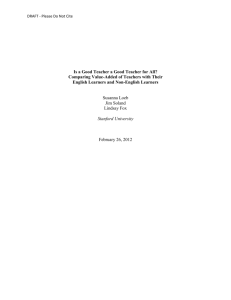Effective and Engaging Communication
advertisement
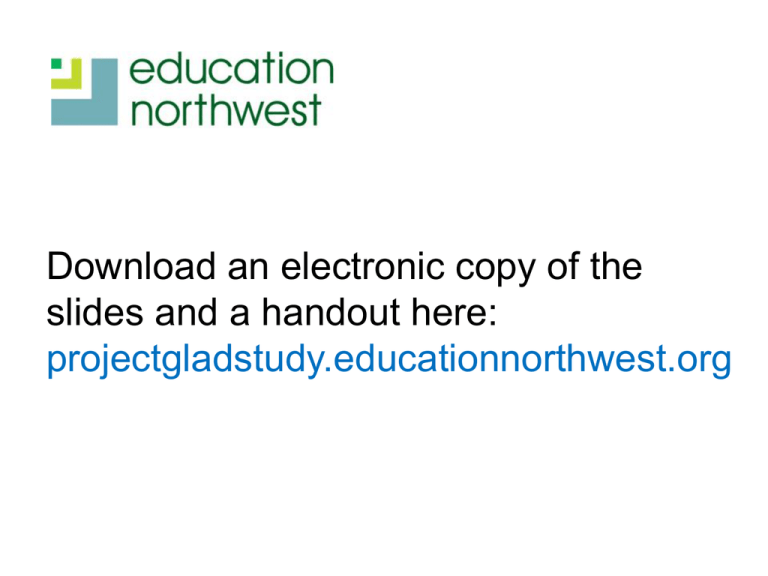
Download an electronic copy of the slides and a handout here: projectgladstudy.educationnorthwest.org Lessons Learned from An Experimental Study of Project GLAD® Theresa Deussen & Claudia Rodriguez-Mojica EL Alliance Conference – March 14, 2014 Do you tweet? @TLDeussen #ProjectGLAD #educationnw Today’s Agenda • Describe Project GLAD and how it works • Report Year 1 results from our experimental study • Take a closer look at what our findings mean for closing the achievement gap • Share some reflections about how professional development might have a bigger impact Language and content SIOP Sheltered Instruction Observation Protocol QuEST Quality English and Science Teaching Project GLAD Guided Language Acquisition Design Project GLAD® (Guided Language Acquisition Design) Key program elements 35 instructional strategies Usable with any curriculum Intended as a coherent package that builds •Readiness and motivation to learn •Content knowledge •Ability to converse at a high level about the topic •Ability to read and write at a high level about the topic What does it look like? Project GLAD Input Chart (One of 35 instructional strategies) 11 How does this compare to what you do in your school? I have never had training that has been this good! Research Questions What is the impact of Project GLAD® teacher training on fifth-grade students’ achievement in ELA and science? – For ELs – For non ELs? Study population 30 Idaho schools 21 districts 50% located in rural communities 2250 grade 5 students 65% Free/Reduced-Price Lunch 33% Latino 62% White 13% ELs Cluster Randomized Trial (CRT) 30 schools agreed to participate 15 received Project GLAD® 15 had “business as usual” Outcome measures English language arts •Reading comprehension •Vocabulary •Essay writing Science •Rocks & minerals unit test •State science assessment Year 1 Literacy Outcomes ELs only Year 1 Literacy Outcomes ELs only Year 1 Literacy Outcomes ELs only 485 Treatment Control 480 475 0.21 0.24 470 465 460 455 Vocabulary Comprehension Pretest What’s an effect size again? Difference between the Tx and C Standard deviation of the group Measure Vocabulary Comprehension ELs Non ELs .21~ .24~ .04 .04 .32* .27~ .05 .22 .05 .02 .19 .12 .21~ .13 .08 .14 .12 .07 .23 .13 Writing Ideas Organization Voice Word Choice Sent. Fluency Conventions Rocks & Minerals State Science Measure Vocabulary Comprehension ELs Non ELs .21~ .24~ .04 .04 .32* .27~ .05 .22 .05 .02 .19 .12 .21~ .13 .08 .14 .12 .07 .23 .13 Writing Ideas Organization Voice Word Choice Sent. Fluency Conventions Rocks & Minerals State Science Measure Vocabulary Comprehension ELs Non ELs .21~ .24~ .04 .04 .32* .27~ .05 .22 .05 .02 .19 .12 .21~ .13 .08 .14 .12 .07 .23 .13 Writing Ideas Organization Voice Word Choice Sent. Fluency Conventions Rocks & Minerals State Science Measure Vocabulary Comprehension ELs Non ELs .21~ .24~ .04 .04 .32* .27~ .22 .05 .05 .02 .19 .12 .21~ .13 .14 .08 .12 .07 .23 .13 Writing Ideas Organization Word Choice Voice Sent. Fluency Conventions Rocks & Minerals State Science What’s a good effect size? Use empirical comparisons. Literacy Effect sizes for ELs Reading Writing Reading Vocabulary Ideas Organization Project GLAD 0.24 0.21 0.32 0.27 SIOP 0.16* 0.19* 0.31** QuEST 0.26 * Small sample with developers involved in training. ** Estimated based on data provided in Echevarria, Short & Powers 2006. Literacy Effect sizes for ELs Reading Writing Reading Vocabulary Ideas Organization Project GLAD 0.24 0.21 0.32 0.27 SIOP 0.16* 0.19* 0.31** QuEST 0.26 * Small sample with developers involved in training. ** Estimated based on data provided in Echevarria, Short & Powers 2006. Literacy Effect sizes for ELs Reading Writing Reading Vocabulary Ideas Organization Project GLAD 0.24 0.21 0.32 0.27 SIOP 0.16* 0.19* 0.31** QuEST 0.26 * Small sample with developers involved in training. ** Estimated based on data provided in Echevarria, Short & Powers 2006. Literacy Effect sizes for ELs Reading Writing Reading Vocabulary Ideas Organization Project GLAD 0.24 0.21 0.32 0.27 SIOP 0.16* 0.19* 0.31** QuEST 0.26 * Small sample with developers involved in training. ** Estimated based on data provided in Echevarria, Short & Powers 2006. Literacy Effect sizes for ELs Reading Writing Reading Vocabulary Ideas Organization Project GLAD 0.24 0.21 0.32 0.27 SIOP 0.161 0.192 0.312 QuEST 1 2 0.26 Small sample with developers involved in training. Estimated based on data provided in Echevarria, Short & Powers 2006. Science Effect sizes for ELs Unit Test State Test Project GLAD 0.19 0.12 QuEST1 0.16 (NA) 1 QuEST also had positive impacts for nonELLs. Back to our research questions What is the impact on Project GLAD on students’ reading, vocabulary, writing, and science achievement? For ELLs? For nonELLs? Starting lower means you need a bigger boost. Vocabulary Comprehension Can Project GLAD close that gap? Multiple years Additive effect? Compounding effect? Reflections Content of the PD Factors affecting implementation Content of the PD Does it prepare teachers to make a difference? Yes Multiple representations of concepts Structured interactions with academic focus Use of primary language Focus on academically useful words Powerful science instruction No Content of the PD Does it prepare teachers to make a difference? Yes Multiple representations of concepts X Structured interactions with academic focus X Use of primary language Focus on academically useful words Powerful science instruction No Content of the PD Does it prepare teachers to make a difference? Yes Multiple representations of concepts X Structured interactions with academic focus X No Use of primary language X Focus on academically useful words X Powerful science instruction X Powerful science instruction Inquiry-based Evidence • Collect • Interpret • Communicate Scaffolding + FOSS kits • (ES = +1.39) What about implementation? Implementation Average number of strategies per week (surveys) Average quality rating (observations) 48 Average 12.5 Range 0-22 69% 19-100% Average number of strategies per week (surveys) Average quality rating (observations) 49 Average 12.5 Range 0-22 69% 19-100% Average number of strategies per week (surveys) Average fidelity rating (observations) 50 Average 12.5 Range 0-22 69% 19-100% The frequency and fidelity of implementation varied significantly across teachers. Average number of strategies per week (surveys) Average fidelity rating (observations) 51 Average 12.5 Range 0-22 69% 19-100% Factors affecting implementation Does the PD make it easy for teachers to implement? Yes On-going Collective participation Explicit protocols for team work Focus on solutions, not activities Coherence No Factors affecting implementation Does it make it easy for teachers to implement? Yes On-going X Collective participation X Explicit protocols for team work X X Focus on solutions, not activities Coherence No X X Teachers also told us what made it hard to implement. Lack of time… Story map—this takes too much time to develop and implement. This is something to do in the summer. Mostly I haven’t used some of the strategies as a matter of time. Social studies is only 30 minutes. Lack of materials… I was worried about the home school connections because I sent things home and I thought about the paper I would have to use. We have a copy limit per month. Lack of confidence in using the strategy… Don’t feel competent as yet to do certain strategies like Team Tasks that are linked to other strategies. Same is true with Group Frame, ELD Review and the Process Grid and Mind Map. I’m not experienced enough to do the reading strategies either. Collaboration may support Project GLAD implementation …[collaboration] changed how I implemented the strategies and how often I did them. The other person gave me an incentive to do things more often and if she hadn't been there I would have done far less. What else might help? Reading Writing Small groups Charts Behavior Walls 1. 2. 3. 4. 5. 6. 7. 8. 9. 10. 11. 12. 13. 14. 15. 16. 17. 18. 19. 20. 21. 22. 23. 24. 25. 26. 27. 28. 29. 30. 31. 32. 33. 34. 35. 36. Standards Scouts Literacy awards T-graph for social skills Team points Personal interaction 10/2 lecture Picture file cards Observation chart Inquiry chart Cognitive content dictionary Graphic organizer Pictorial input Comparative input Narrative input Sentence patterning chart Chants/poetry Story map Mind map Process grid Team task Expert group ELD group frame ELD review Numbered heads Cooperative strip paragraph Writers’ workshop Learning logs Interactive journals Portfolios Big books Clunkers/links Focused reading Ear-to-ear reading Home/school REPEATED _________________ Used * * * * * * * Revisit R1 R2 R3 R4 R5 R6 R7 R1 R1 R2 R2 R3 R4 R5 R1 R2 R3 R4 R1 R1 R1 R1 R1 R1 R1 R1 R1 R1 R1 R1 R1 R1 R1 R1 R2 R2 R2 R2 R2 R2 R2 R2 R2 R2 R2 R2 R2 R2 R2 R2 R3 R3 R3 R3 R3 R3 R3 R3 R3 R3 R3 R3 R3 R3 R3 R1 R2 R1 R2 R5 R6 R7 R4 R4 R4 R4 R4 R4 R4 R4 R4 R5 R5 R5 R5 R5 R5 R5 R5 R5 R6 R6 R6 R6 R6 R6 R6 R6 R4 R4 R4 R4 R4 R5 R5 R5 R5 R5 R6 R6 R6 R6 R3 R4 R5 R6 R3 R4 R5 60 R8 R9 R10 R7 R7 R7 R7 R7 R8 R8 R8 R8 R9 R9 R9 R10 R7 R7 R8 R8 R7 R8 R9 R7 R8 R9
